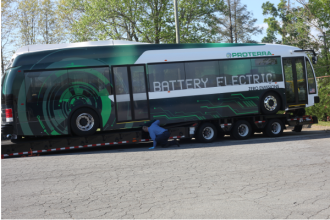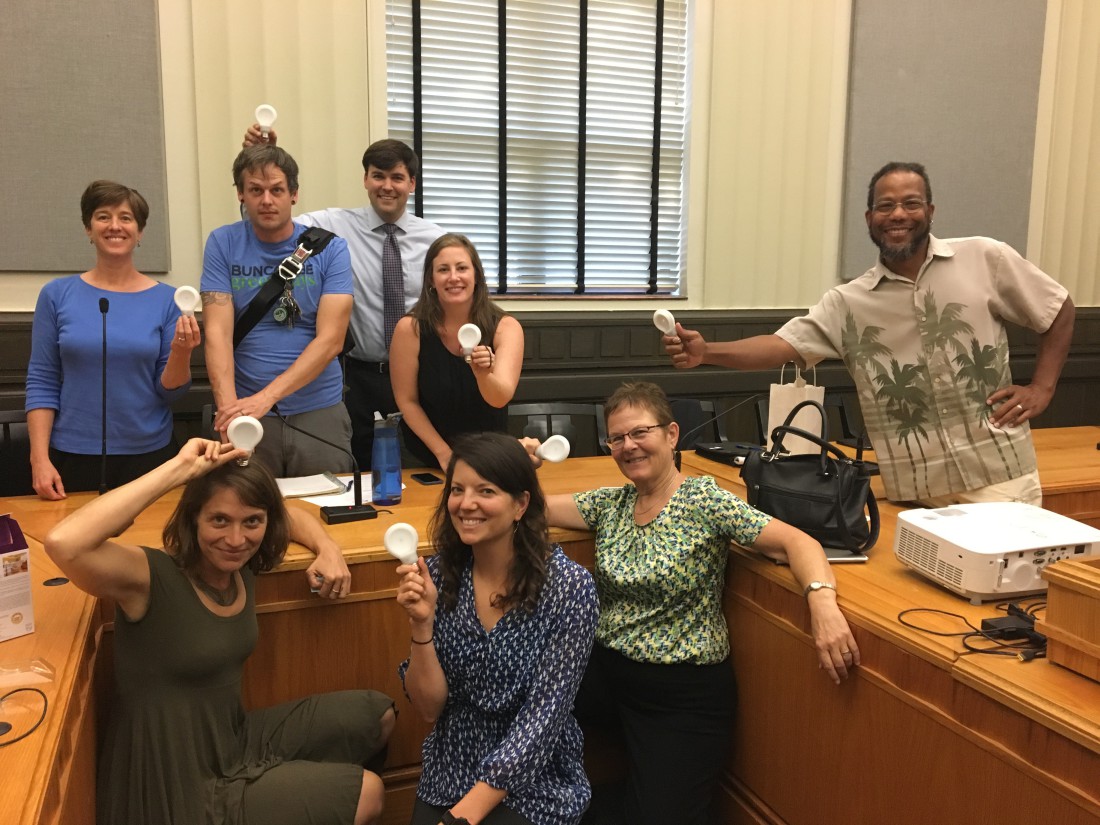Asheville’s greenhouse gas emissions weigh heavily upon the city — to the tune of approximately 19,000 tons. According to the city’s Office of Sustainability, Asheville’s municipal operations released that amount of carbon dioxide and equivalent gases during the course of fiscal year 2017.
The plurality of those emissions (48.1 percent, or roughly 9,100 tons) came from burning fossil fuels, such as coal and natural gas, to create electricity. That number could drop to zero by the end of the next decade, however, should Asheville adopt a resolution currently under development by the city’s Sustainability Advisory Committee on Energy and the Environment.
On Wednesday, Aug. 15, SACEE members will vote on whether to call for the city to commit to using 100 percent sustainable electricity for municipal operations by 2030. If the resolution passes, says committee Chairman John Noor, it will go before City Council’s Planning and Economic Development Committee for review, with approval by the full Council possibly to follow in October or November.
Noor says the resolution exceeds similar language passed last December by the Buncombe County Board of Commissioners, which commits the county to using 100 percent renewable energy for all operations, including its vehicle fleet, by 2030.
“The draft resolution goes further than the county’s goal by including accountability metrics that require the city’s Office of Sustainability to annually certify to City Council that the city is on track to achieve the transition goals and has sufficient funding to implement the projects needed to accomplish the transition within the adopted timelines,” Noor explains.
Absolute zero
A 100 percent sustainable electricity solution for the city, Noor says, would provide all municipal electricity needs from renewable electricity sources such as solar, hydro, hydrogen and wind power. He clarifies that this approach would focus on the direct use of clean energy, rather than buying renewable energy credits to counter the impact of fossil fuels.
“Some other communities have interpreted similar goals to allow the purchase of RECs to offset electricity that is not or cannot be sourced from renewable energy,” Noor says. “At this point, SACEE is not recommending that RECs be a part of Asheville’s plan because we want the city to prioritize funding solutions that transition electricity demand in our community to renewables produced in our region. However, this is an option that may be explored in the future.”
The SACEE resolution also includes wording that would have the city “aspire to transition all municipal energy demand to renewable sources as soon as practicable.” This goal would eventually eliminate the remaining 51.9 percent of the city’s greenhouse gas emissions, which come from a mix of natural gas, compressed natural gas, biodiesel, gasoline and propane. While the current resolution offers no timeline for such changes, Council has previously adopted a resolution calling for 100 percent renewable energy across North Carolina by 2050.
Jeremiah LeRoy, sustainability officer for Buncombe County, is pleased by the proposed resolution and believes that different levels of government can work together to achieve ambitious goals. “Both the city and the county can play a pivotal role in setting the course for a clean energy future for Western North Carolina, and this resolution would represent a significant step in making that future a reality,” he says. “The Buncombe County Sustainability Office is committed to working with its counterparts at the city … to reach our goal of transitioning our community to clean, renewable energy.”
Green for greening?
While Amber Weaver, sustainability officer with the city, supports a renewable energy transition, she questions whether the proposed resolution’s approach is financially feasible. “Part of my job is to think about budget, and I am responsible for being that voice that says we’ve got to think about the budget and how it impacts people’s lives,” she says.
“There are many different perspectives on this issue, and we have to figure out what the steps are that we need to take, as well as what is affordable,” Weaver continues. “We have to have a better understanding of what is possible within the constraints that the city has to operate in.”
Council member Julie Mayfield, SACEE’s Council liaison, agrees that some of the resolution’s goals may not yet be possible. Running garbage trucks and other city fleet vehicles on renewable energy, for example, would require technology that is still under development.
“I do hope and continue to believe that we will transition our fleet to electricity, but we don’t know what that looks like right now,” Mayfield says. “We would like to see some solution in the future, but right now, that’s not possible.”
For Mayfield, the issue boils down to what steps can be taken now — particularly low-cost solutions like increasing energy efficiency — what costs the city may incur in the future and what investments in RECs are appropriate. She adds that Council approved a resolution that would jointly fund a request for proposals with Buncombe County to study how the area can transition to sustainable electricity, but no solutions or plans have yet been finalized.
Meanwhile, Mayfield says, the city hopes to work with Duke Energy to use land at the Asheville Water Treatment plant in Mills River to provide solar energy to the area, much as Buncombe County does at its landfill. She would also like to see the city make use of the potential for hydroelectric power at surrounding dams.
“We’re doing a lot of things [toward reducing the city’s carbon footprint], and we’re making decisions about renewable energy as we make those transitions,” Mayfield says. “But that doesn’t mean that we will do that at all costs.”
Cutting back
Ken Brame, political chair for the Sierra Club of Western North Carolina, argues that one of the keys to reaching the resolution’s goals will be energy conservation. Reducing usage in general, he says, would not only reduce emissions but also create a virtuous cycle of available funds.
Brame explains that the city is already taking numerous opportunities to conserve energy that have reduced its usage by 30 percent. Simple steps such as employing LED bulbs in light fixtures, upgrading old insulation and replacing outdated heating and air-conditioning units have saved the city $600,000 per year and will continue to do so in perpetuity. “We’d like to see them invest that in other renewable energy solutions,” Brame adds about those savings.

But Brame encourages the city to include all energy, not just electricity, in its 100 percent renewable energy goal. “For instance, they just purchased electric buses that would have the opposite impact on the city’s electricity usage by increasing the amount of electricity it needs to power them,” he says. While in favor of the bus purchase, Brame suggests the city should consequently seek other ways to cut its overall energy demand.
Bridget Herring, electricity coordinator for Asheville’s sustainability office, notes that while the new buses will use more electricity, they will also cut down on the city’s biodiesel consumption and reduce overall carbon production. “Our electricity has lower carbon emissions than biodiesel, and we estimate that the five electric buses scheduled to come online in January 2019 will contribute just shy of 1 percent of the city’s 4 percent annual carbon reduction goal,” she says.
Herring adds that Asheville’s current energy reduction efforts include efficiency upgrades to the pump technology in its water distribution infrastructure, as well as solar thermal systems at several of the city’s fire stations, which use the sun instead of electricity to provide hot water.
Noor agrees that cutting energy demand will be crucial to successfully implementing the SACEE resolution. “Every kilowatt of energy we avoid using is one less kilowatt we have to power with renewable electricity,” he points out. Additionally, an energy reduction approach dovetails with the work of the Energy Innovation Task Force, a partnership between the city, Buncombe County and Duke Energy Progress that aims to avoid the construction of an additional natural gas power plant at Duke’s Lake Julian facility.
The challenge of clean energy transition will be significant and complex, but Weaver says recent events have only highlighted the need for cities like Asheville to lead the way. “This action, and actions like this in cities across the country, all stem from the president’s pulling out of the Paris Climate Accords,” she says. “Cities are stepping up to take this on. … It’s a huge elephant, and we’re just going to have to take a little bite at a time.”
Editor’s note: This story was updated on 8/14 at 10 a.m. to more accurately reflect statements made by Ken Brame.



Awesome news! But let’s not forget that transportation accounts for almost a third of all greenhouse gas emissions with the single passenger automobile accounting for much of this unnecessary pollution. Do the planet a favor and leave your car parked more often
LOL I believe in unicorns, tooth fairies, and Santa Claus. Especially when I’m in government and have never had to not only work a real job, but never pay for the insanity.
Actually there are already garbage trucks (and other heavy vehicles) on the market that run on batteries. I looked into it while I was on Council.
The only energy lacking is political will.
(But I applaud all efforts to move in a better direction.)
Given the state of the art, I’d suggest that most vehicle purchases by the City ought to be fully electric. One of the weirdest choices I saw during my years there was that the APD had the second plug-in cop car after NYC (a Volt, which plugs in but has a gas engine to step in when the battery is low), but apparently assigned it to an officer with a desk job. So the most efficient car in the fleet was assigned to an officer with the least need to drive. (???)
Given the zip of electric motors (really fast zero-60), it would make great good sense to use the Volt for traffic enforcement.
Ah, bureaucracy.
I passed the Police Volt almost daily while I traveled Charlotte Street to work, and I thought about how wasteful the City was for buying a brand new vehicle to just sit and occupy an electric charging station day in and day out. One day, my curiosity got the better of me, so I stopped in the City garage to inquire. The fleet manager I spoke to (something Stevens) was really nice, but he said that the police hated the Volt, and that they only bought it because SACEE made them, and that no one on patrol would drive it, so they had to assign it to an Admin guy.
I applaud the lofty goals, but they’re useless if weak managers can’t get their subordinate staff to implement them.